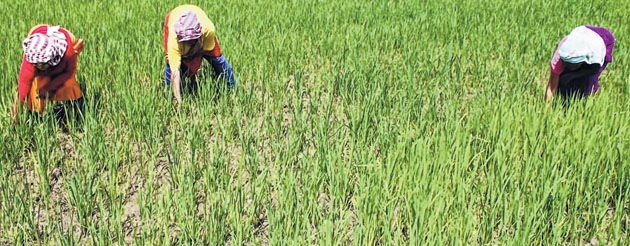Erratic monsoon poses stiff challenges to farmers
|

Nando Waikhom
IMPHAL, Aug 5: At a time when the Central Government is laying emphasis on boosting farmers’ income in the country, farmers in Manipur are facing stiff challenges in sustaining a conventional form of agricultural practice against the backdrop of erratic monsoon.
According to the data received from Indian Council of Agricultural Research (ICAR), Lamphelpat, the State in this year had a rainfall deviation of -48.44 % in January, -80.67 % in February, -26.84 % in March, -55.41 % in April, -31.62 % in May, -12.99 % in June, -8.41 % in July and 23.10 % in August.
With the deficient and change in the pattern of monsoon rainfall, the farmers are being compelled to spend more money in meeting the requirements of agriculture, especially in the management of irrigation water.
Moirangthem Manimohon, a tenant farmer from Pourabi Awang Leikai in Imphal East asserted that farming can no longer be sustained as a profitable occupation in the State.
Saying that he hardly managed to broadcast rice seeds despite very scanty water in his paddy fields, Manimohon claimed that he has so far spent around Rs 20,000 per sangam in his paddy field, which he said is relatively higher than the amount incurred last year.
“Apart from the skyrocketing fuel price triggering the ploughing charge considerably higher in this agricultural season, farmers used to expend huge money in the management of irrigation water, cleaning weeds and putting fertilizers”, he said.
While expressing dissatisfaction on the current state of his crops, the tenant farmers expressed worry that he might get into debts this season if he gives away the yield share of his paddy field owner as usual.
K London, another farmer from the same village maintained that the traditional/conventional form of agriculture which solely relies on monsoon has been quite vulnerable to the erratic monsoon being experienced in the last few years.
Asserting that farmers used to face the recurring problems of water shortage, followed by fertilizers shortage and inundation of paddy fields almost every year, he deplored that the value of the yield receiving at the end of a harvest season is almost same to the total amount incurred in the entire process of agriculture.
He stated that many farmers like him in Pourabi area are now intensely worrying whether their crops will not yield much harvest in this season as the lack of water in paddy fields has led to the retardation and infestation of many crops in and around the village.
On the other hand, Nongthombam Gulapi, a 72 year old farmer from the same village claimed that the deterioration of the source of irrigation facilities in and around Pourabi has immensely disrupted agriculture.
He said some of the waterways ( ishing khong/loukhong) which used to provide irrigation facilities in Pourabi area have become very shallow and narrow due to the encroachment.
The aged farmer rued that the water shortage in the paddy fields of the village could have been mitigated to a great extent if the irrigation waterway (loukhong) from Huidrom to Pourabi is functional.
Making similar views and estimates to that of Gulapi, London asserted that as a part of conserving the environment, a local committee set up by a group of dynamic youths and villagers in Pourabi have now restricted deforestation in Chengba Makou Hills.
Meanwhile, NIT, Langol’s Head of Civil Engineering Department Dr Ngangbam Romeji pointed out that Manipur, part of the Indian Himalayan Region (IHR) has been experiencing stochastic and indeterminate changes in the hydrosphere and monsoon patterns.
He said the bountiful hydroclimatic region of the Manipur–North East Indian Himalayan Region (IHR) is dwindling and becoming fragile in its environment with the unprecedented climatic variations in the past two to three decades causing devastating floods, droughts, landslides etc.
Informing that this IHR portion of Manipur occupies 4.18% of the Indian Himalayan Region, the Professor maintained that the region shows great variation in temperature regime which varies from 15°C to 32°C in summer and 0 to 26°C in winter.
He said that a research study deploying a diagnostic atmospheric model to estimate the amount of recycled rainfall, suggests that about 7 % of the total rainfall which was contributed by the local moisture recycling has decreased about 30 to 50 mm.
He conveyed that a gridded observed rainfall and sea surface temperature data of the last 114 years (1901-2014) has also indicated that the decreasing trend of summer monsoon rainfall is rather associated with the strong interdecadal variability of the subtropical Pacific Ocean in Manipur - NE IHR.
The Professor further observed that the strong interdecadal variability over the region predicted a possibility of decadal prediction of the monsoon development and rainfall. He added that all these factors disrupted the orographic distributions and formation or dissipation of rain-bearing clouds. The Professor noted that there is a marked decline of forest and vegetation cover from 16505.98 square kilometres in 2011 to 15890.24 square kilometres in 2019.”, he said
(This feature was written under Media Fellowship on Climate Change reporting of the Directorate of Environment & Climate Change, Manipur)